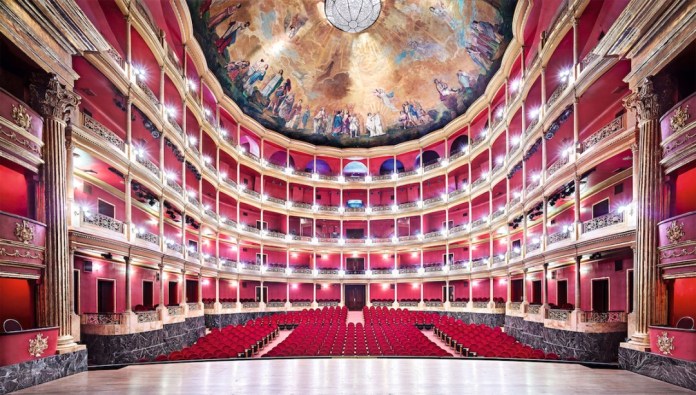In Mexico foregrounds Höfer’s images as records of a site’s architectural and sociopolitical history.
Candida Höfer’s photographs are so geometric and so precise that they can appear slightly uncanny, leaving viewers vaguely unsettled. Her work has been described as a “deadpan inventory of public spaces,” “chillinglingly awesome,” containing a “hostility … that is bracing,” and possessing a “classical concept of beauty.” These characterizations point to a quality in the work that might be called a cold exquisiteness that alternatively beckons and repels. The artist’s latest exhibition at Sean Kelly Gallery, Candida Höfer – In Mexico, expands her signature attention to complex facades and interiors to include more focused images of architectural detail. The photos in the exhibition are from Höfer’s participation in Mexico-Germany Dual Year, a cultural exchange program that sent German artists in various disciplines to Mexico.
Höfer’s work is often contextualized by her studies at the Kunstacademie Düsseldorf under the tutelage of photographers Bernd and Hilla Becher. The Bechers also taught Andreas Gursky, Thomas Struth, and Axel Hütte, and certain similarities are evident among the pupils — for instance, a knack for capturing a sense of vastness within a delineated space, an overt preoccupation with geometry and scale, and a deliberately distinct style or visual imprint. However, beyond these parallels each photographer’s work is quite different, and Höfer’s frequent grounding within this group prioritizes a focus on the formal elements of her work. How, then, to look at Höfer’s work without focusing on the formal elements? In Mexico offers two alternatives. The first is to foreground her images as records of a site’s architectural and sociopolitical history; the second is to examine the photos within the context of their installation.


Whether by accident or design, In Mexico evokes four broad currents of Mexican society: indigenous culture; the Catholic Church; struggles for political independence; and architectural and artistic modernism. In many cases her images touch on more than one theme. For example, “Iglesia de Santa Maria Tonantzintla I 2015” shows a 17th-century church in Cholula, Puebla whose style is both local and Baroque. The dense imagery in the building’s interior is replete with indigenous motifs of flora and fauna, and the name of the building refers to Tontantzin, an Aztec goddess who became an iteration of the Virgin Mary after the adoption of Christianity in the region.
Hospicio Cabañas, a world Heritage Site in Guadalajara, Jalisco, founded in the early 18th century by the Archdiocese of Guadalajara to serve the poor, sick, and disabled, makes two appearances in the exhibition. The building was designed by Manuel Tolsá, inspired by such structures as Les Invalides in Paris. Höfer’s images capture two artistic interventions within the original space: 1936 murals by José Clemente Orozco and a brightly colored 2014 installation by Daniel Buren. Both photographs speak to the enormous power of the Catholic Church and the tradition of murals in Mexico.


A gorgeous image of blue glass in the ceiling of “Palacio de Bellas Artes Ciudad de México II 2015” represents a slice of a building constructed in 1910 to honor the centennial of the Mexican War of Independence. During the initial construction phase the Mexican Revolution broke out; consequently the Palacio was not finished until 1934. The structure contains murals by Diego Rivera, David Siqueiros, Rufino Tamayo, and José Clemente Orozco. Constructed to honor one revolution, the Palacio was left unfinished for over 20 years because of another. While Höfer’s photo does not convey this history explicitly, its gorgeous blue light alludes to political idealism — the artist’s lens aimed upward might symbolize progress and idealism.
The precision of Höfer’s large-format photos can suggest that she has fully captured a space. In Mexico brilliantly upends this fallacy, with photographs of the same location installed next to each other or on opposite walls. For example, “Teatro Degollado Guadalajara I 2015,” “Teatro Degollado Guadalajara II 2015,” and “Teatro Degollado Guadalajara III 2015” form a V shape on opposing and adjacent walls. “Teatro Degollado Guadalajara I 2015” captures the 1886 theatre from an audience-facing position onstage, “II” shows the curve of the seating area, and “III” reverse the viewpoint of “I” so that viewers are looking at the stage. Their installation enables the works to speak to one another. It creates a fluidity rather than a static sense of space and perspective, and establishes each image as the result of a framing choice, with multiple other potential perspectives. This importantly allows Höfer’s photos to replace, as Michael Kimmelman writes in theNew York Times, the quality of being “Empty and vast … just occasions for photographic spectacle” and display dynamic interrelationships. While her technical prowess and distinctive style clearly propel her artistry, In Mexico shows Höfer’s work enlivened by new frames of reference.

Candida Höfer – In Mexico continues at Sean Kelly Gallery (475 Tenth Avenue, Manhattan) through March 16.
Source: The Mazatlan Post

